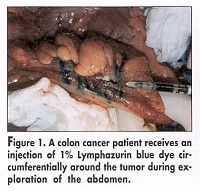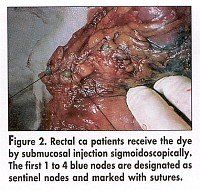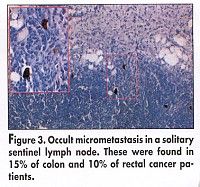Sentinel Lymph Node Mapping Is Successfully Performed in Rectal Cancers
WASHINGTON-Sentinel lymph node (SLN) mapping has been used in gastrointestinal cancers to identify patients with occult micrometastases who might benefit from adjuvant chemotherapy. Because rectal lymph drainage is "less predictable" than colon lymph drainage, the technique had been considered less suitable for rectal than for colon cancers, said Sukamal Saha, MD, of the McLaren Regional Medical Center of Michigan State University, Flint.
WASHINGTONSentinel lymph node (SLN) mapping has been used in gastrointestinal cancers to identify patients with occult micrometastases who might benefit from adjuvant chemotherapy. Because rectal lymph drainage is "less predictable" than colon lymph drainage, the technique had been considered less suitable for rectal than for colon cancers, said Sukamal Saha, MD, of the McLaren Regional Medical Center of Michigan State University, Flint.
Now, a prospective study has found that SLN mapping "works in both colon and rectal cancers in more than 92% of cases," Dr. Saha reported at the 54th Annual Cancer Symposium of the Society of Surgical Oncology.

The study involved 214 consecutive colon and rectal cancer patients (164 colon and 50 rectal), ranging in age from 26 to 97, who underwent SLN mapping at the time of surgery. Colon cancer patients received injections of 1 mL to 2 mL of 1% Lymphazurin blue dye circumferentially around their tumors during exploration of the abdomen (Figure 1). Rectal cancer patients received the dye by submucosal injection administered sigmoidoscopic-ally. The first one to four blue nodes found were designated as sentinel nodes and were marked with sutures (Figure 2).

With success defined as finding a blue node, SLN mapping proved as statistically successful in rectal as in colon cancers, he said. An SLN was identified in 99% of colon cases and 92% of rectal cases.

Occult micrometastasis in one solitary SLN was found in 15% of colon and 10% of rectal cancer patients (Figure 3). Accuracy in identifying the presence or absence of metastasis in the SLN was 98% in colon and 90% in rectal cancers. In 5% of patients, the technique leads to a change in the extent of the operation.
There were no adverse effects seen in any of these 214 patients, Dr. Saha said. Even in patients who received neoadjuvant radiation therapy and chemotherapy for rectal cancer, the technique was successful in more than 92% of cases.
SLN mapping thus appears to permit better identification of micrometastases than standard methods, he said. "These upstaged patients may then receive adjuvant chemotherapy, which may affect their long-term survival," he said.
Newsletter
Stay up to date on recent advances in the multidisciplinary approach to cancer.